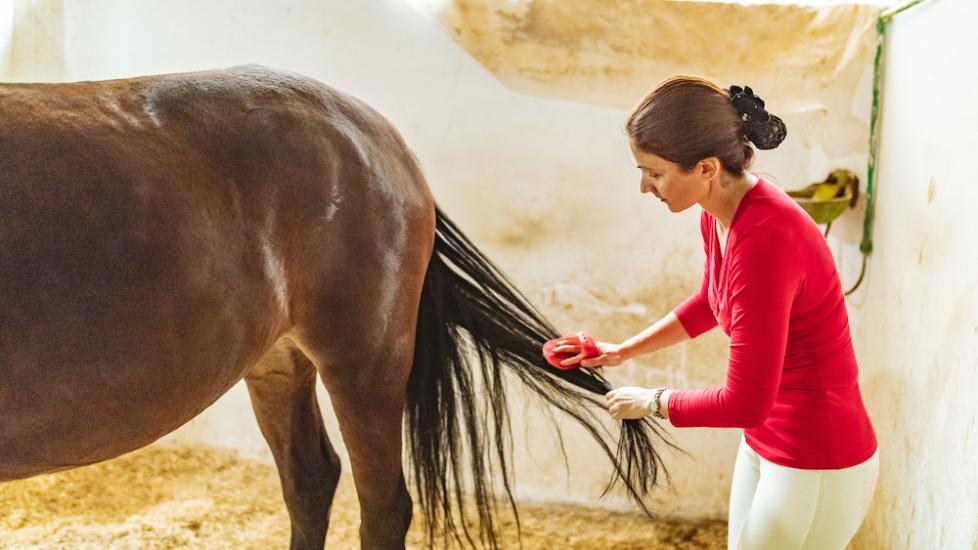Tail Rubbing in Horses
What is Tail Rubbing in Horses?
Tail rubbing can be a frustrating condition for many horse owners. Itchiness is the primary cause of tail rubbing and horses will do anything to fix the itch. They will back their rear ends up to a gate, a wall, a fence post, anything they can find, to provide some relief. There are many potential causes of itch in horses that can result in tail rubbing. Figuring out which is the problem for your horse is the first step in fixing those broken tail hairs.
Symptoms of Tail Rubbing in Horses
Horses that rub their tails may exhibit:
-
Broken tail hairs and hair loss at the base of the tail
-
Red, inflamed skin at the tail base
-
Scabs/crusting of inflamed skin
Causes of Tail Rubbing in Horses
Potential causes of tail rubbing in horses include:
-
Pinworms (Oxyuris equi)
-
Sweet itch (Allergic dermatitis)
-
Insect bites
-
Dirty udder/sheath
-
Sunburn
-
Boredom
-
Other fungal or parasitic causes (much less common)
How Veterinarians Diagnose Tail Rubbing in Horses
The first step to getting your horse’s tail back into shape is to figure out the cause. Your veterinarian can be very helpful in making this diagnosis. They will examine your horse’s tail, their rectum, and the skin of their hind legs as well as their udder or sheath area. Most causes of tail rubbing will be visible to the naked eye.
If all the common causes of tail rubbing have been ruled out, your veterinarian may recommend performing a skin scraping, tape test, or even a biopsy to determine if there is another possible cause of itching.
Treatment of Tail Rubbing in Horses
Treatment of tail rubbing is dependent on the cause:
-
Pinworms are a GI parasite that are usually missed in fecal egg counts. Your veterinarian will check the skin of the rectum and underneath the tail for evidence of these tiny parasites. Pinworms are very common and have become increasingly resistant to normal deworming agents. Talk to your veterinarian about the best dewormer or combination of dewormers to use.
-
Sweet itch is the name for allergic dermatitis in horses, one of the many skin problems horses can experience. It can be secondary to fly bites or pollens, molds, or other irritants in the environment. Your veterinarian may recommend fly spray, deworming and/or antihistamines such as Cetirizine (Zyrtec).
-
Some horses are especially sensitive to insect bites. Consistent use of fly sprays, masks, and sheets can be very beneficial for these horses.
-
If there is no significant evidence of other allergies or parasitism, your veterinarian will check your horse’s sheath or udder. Smegma (a combination of shed skin cells, skin oil, and moisture), dirt, and secretions from the horse’s skin can build up in the sheath and become irritating. Horses are not good at itching this area directly so will often rub their tails to try to get some relief. Your veterinarian will clean the area and remove the irritating debris.
-
Very light skinned horses can develop sunburn on areas that are covered with white hair. Zinc oxide lotion can be beneficial in protecting the skin and allowing it to heal.
-
Unfortunately, some horses just rub their tails because they’re bored. This can be one of the hardest causes to treat. Increased exercise, a change in stall or paddock location, more forage or other forms of enrichment can be beneficial when all medical causes have been ruled out.
Recovery and Management of Tail Rubbing in Horses
Once you’ve gotten your horse to stop rubbing its tail, how do you keep it from starting again? This depends a lot on the original cause too. A few tips to help manage your horse’s tail rubbing include:
-
Keep in touch with your veterinarian on performing fecal egg counts to help determine the best deworming schedule for your horse
-
Use fly sheets, masks, and sprays for fly protection
-
Routinely check your horse’s udder/sheath for dirt and smegma buildup
-
Use zinc oxide products consistently on white areas of light skinned horses
-
Increase turnout and/or provide additional enrichment to prevent your horse from rubbing out of boredom
-
Avoid over brushing your horse’s tail and make sure any products are thoroughly washed out after bathing to prevent contact reactions
Tail rubbing can be very frustrating and unsightly, but it can be treated. Be patient and diligent and soon you’ll have your horse’s beautiful tail back again.
Featured Image: iStock.com/zoranm
